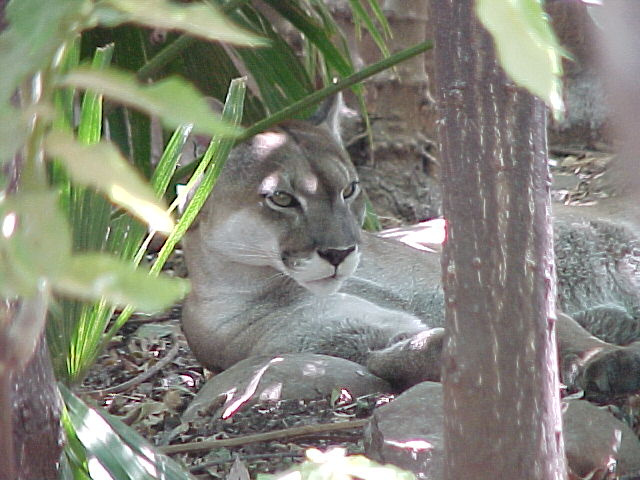
More about Puma
Habitat
The puma can tolerate habitats varying from temperate, coniferous forests to low, multistrata, and tropical rainforests.
Range
From British Columbia to Patagonia, the puma lives between elevations above 2,000 m down to sea level.
Physical Description
One of the largest cats in the Americas, the puma is second in weight only to the jaguar.
Adults are generally cinnamon to rufous brown with a white underside, but young pumas are spotted, and with subsequent molts their coloring gradually becomes more like that of adults. Until they are 6 months old, though, they can be difficult to tell from juveniles of the jaguar or other spotted cats.
Biology and Natural History
The tropical puma is smaller than its brother in temperate North America, most likely because it finds smaller prey in the Tropics. Still, the puma is an excellent hunter and athlete in the lower regions of its range: it can leap 16 feet into the air, and is a good climber even though it spends more time on the ground. The puma generally stalks its prey from behind, usually first attacking the back of the neck.
The puma can have 1-6 young to a litter, but generally has 2-3 kittens once every 2-3 years. This cat lives an average of 9 years in the wild, but can live to the age of 20 in captivity. Although this is indeed an adaptive big cat, an adult still requires a large territory of 75 km2 in the wild; an area of 100,000-200,000 ha is necessary to support a viable population unless there are sufficient corridors for them to contact each other. With deforestation and habitat destruction in the Tropics, it is becoming increasingly difficult for pumas to survive because there are fewer available areas large enough to support their territorial needs.
It also has the largest range of all terrestrial animals in the Americas, because it can tolerate a wide range of habitats. In the Tropics, the puma can overlap with the jaguar in range and territory, but the larger jaguar is usually dominant to the puma and the puma accordingly adjusts its placement to avoid contact with its cousin. Given enough space, this is not too difficult for the puma, since it can survive in a wider range of habitats than the jaguar. With its adaptability, the puma is more dominant even than the jaguar in southern Patagonia as well as at high elevations in the Andes.
In some places the puma has a misallocated reputation for being dangerous to humans. In the last 100 years, only 44 fatal attacks have been recorded over the entire span of the North and South American continents.
Diet
The puma specializes on medium to large game. In the northern range, it frequently hunts deer; in the Tropics, it often eats monkeys, rats, and coatis.
Height/Weight
Adult males can be more than 2.7 m long with a tail 60-70 cm long and weigh 60-100 kg. Females are smaller, 1.5 to 2.3 m total in length. Size varies over the geographic range of the species.
Taxonomy
Order: Carnivora
Family: Felidae
Source
Eisenberg, John. Mammals of the Neotropics, Vol. 1. The University of Chicago Press: Chicago, 1989.
Wilson, D. E. in Janzen, Daniel H. Costa Rican Natural History. Chicago: University of Chicago Press, 1983.
-Amy Strieter, Wildlife Writer
Puma Sightings
Similar Profiles
We believe travel is more than ticking destinations off a list – it’s about discovering new places deeply, feeling connected wherever you go, and knowing you have a trusted team behind you every step of the way.



